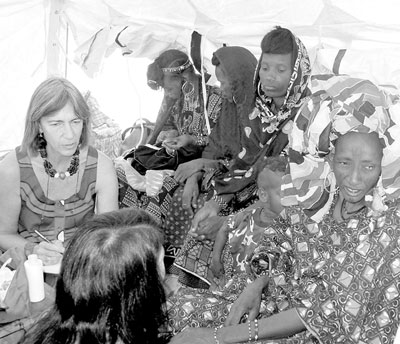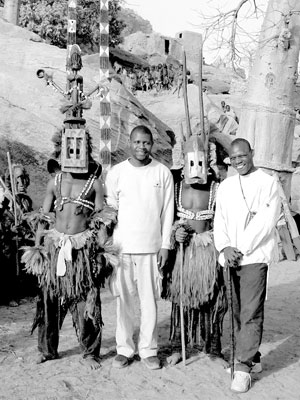Reciprocal tourism with Turtle Tours
I had already taken two tours with Turtle Tours (Box 1147, Carefree, AZ 85377; phone 888/299-1439 or 480/488-3688, fax 480/488-3406, e-mail turtletours@earthlink.net) when I received the brochure which read, “Join us as a volunteer. Come on a 2-week program as a Health Care Professional or Staff Assistant for which no medical training is required. You will be a great help and get to know our tribal friends.”
The brochure described medical projects which are run by TurtleWill (e-mail Irmaturtle@turtlewill.org), the humanitarian arm of Turtle Tours, Inc.
It sounded great. Here was a way for me to travel again in destinations which I had enjoyed and to feel that, in less developed countries where there is so much need, I was doing more good than just supplying “tourist dollars.”
So in March ’03 I went on a medical mission to Niger. I found the trip so rewarding and meaningful that I signed up for trips to Ethiopia in August ’03 and Mali in January ’04. I found each to be a great combination of “sightseeing” along with humanitarian work.
Each medical mission comprised two doctors and three to five assistants. As assistants, we were mainly pill-counters and “gofers.” We would place the various medications, which ranged from antibiotics and antimalarials to antacids and vitamins, into small plastic bags each labeled with the medication name and strength. The doctor would then mark the label with a symbol that told the recipient how many pills to take and when to take them.
Our clinic would be set up in a canvas tent near a remote village or nomadic camp. The clinic typically ran two days at each site, hitting three sites in each country. We would work hard for six days of the 2-week trip and spend the rest of the time traveling, sightseeing and following up with ongoing projects. Even on our clinic days there would be times that the work was caught up and we “assistants” could take turns visiting the village and socializing with the people.
The doctors, however, were busy most of the time. Our doctors treated almost 900 patients on the Niger expedition, 1,400 in Ethiopia and 1,000 in Mali.
In NIGER we held one clinic in an area that I had visited on my Turtle Tours Wodaabe Festival tour, and how exciting it was to be welcomed back by people who remembered me. In between that clinic and others, we visited the Bianou Festival in Agadez and spent the day following a Tuareg procession about six kilometers into the city. The Blue Men of the Sahara marching and dancing followed by their camels and surrounded by women in their finery was a sight I’ll never forget.
In Niger, some projects were follow-ups to several women’s cooperatives that had been started in previous years. The cooperatives had been given “seed” money to get businesses started, and they now use the profits from sales to purchase more raw materials. Some cooperatives were doing leather work and sewing with equipment that TurtleWill provided. Others were buying food and supplies in bulk and reselling to members at the discount prices.
We saw and learned about schools that have doubled their enrollment since TurtleWill began providing noon meals, enabling students to come from greater distances; wells that had been dug to provide water, and a vegetable garden that has been planted.
Men reported on the Hapbanai project in which animals donated by TurtleWill are loaned to needy families until they produce offspring, whereupon the family keeps the young, and the donated animal goes to others in need.
We also visited associations of handicapped persons that had received wheelchair tricycles and begun cooperative projects from TurtleWill. Many of these people with withered legs were now in their wheelchairs operating their businesses, which included chair weaving, sewing and jewelry making. The dignity they seemed to display was so different from that of people I had seen in other countries crawling with flip-flops on their knees and begging.
In ETHIOPIA we did one clinic high up in Mago National Park with the Mursi (plate-lipped) people. The other two clinics were held in Hamar areas that I had previously visited — more old friends to greet. Along the way we met students who were being sponsored individually by Turtle Tours participants. These young people reported on their educational progress.
We also visited people who had been helped in previous years. Most moving was a visit to the home of a woman who had been sent to the hospital for leprosy on the previous year’s trip. She is now much better and happy with the leprosy almost cured.
We also met a man who had been sent to Addis Ababa for surgery on his face after an automobile accident. He is doing well and was extremely grateful.
In MALI we attended the Festival of the Desert, an internationally renowned music festival held about 30 miles from Timbuktu. We then held clinics at a Tuareg refugee community near Timbuktu, at two remote Songhai villages near Homburi and at the Dogon village of Yandouma.
The Tuareg community danced and sang for us in a “Thank you” and “Good-bye” celebration. Each of the Songhai villages presented us with a goat which later turned up in our meals. And when I walked around the market in Yandouma, people repeatedly came up to me to say “Thank you” for bringing medicines to their village. It made me glad to be even a small part of the expedition.
The Handicapped Association of Mopti presented us with specially made T-shirts as thanks for helping them raise money to furnish a building where their music group could give concerts and to purchase a bus so the group could travel to other areas.
At Homburi the clinic was a nice building, but we were apalled that it had only one bed and no mattresses. When our doctors advised that the mattresses were the more important, we each bought a mattress for the clinic. The $20 was better spent on that than on some souvenirs I have bought in my travels.
Among the illnesses we encountered in these areas, malaria, bilharzia, intestinal parasites, nutritional deficiencies and respiratory problems were common. Occasionally we found a serious case where the person needed to be transported to a hospital, and one of us would accompany the family in one of our vehicles. In the Dogon we transported a baby with meningitis, visited him a few days later and happily saw signs of recovery. Our two doctors in Mali were both pediatricians, two of only 14 pediatricians in the whole country.
Since Irma Turtle has taken tour groups to these areas for years, she was able to surprise us with delights, such as a performance by more than 25 masked Dogon dancers on our last day in that area.
On these TurtleWill medical expeditions, most nights were spent in tents. Where available, we stayed in hotels. The trips were priced like regular tours, each running around $4,500, land only (Mali was 18 days and the others were more like 14 days). However, the costs of the tour as well as the airfare were tax deductible as a charitable expense. In fact, the price not only covered our expenses but paid for the local medical personnel as well as medicines.
I came away with not only a feeling of satisfaction but a feeling of optimism that we were planting seeds that might grow. In Niger we had two volunteer American doctors; however, in Ethiopia and Mali we had local doctors. The African doctors were wonderful men who were excited to be traveling to the areas where we held clinics. It was an eye-opener for them — and hopefully the beginning of a movement now that they are aware of the conditions of health care in these remote areas of their own countries.
If you are interested in visiting tribal peoples in Mali, Niger or Ethiopia and are interested in helping them through reciprocal tourism, I can recommend these medical missions.
DORIS NEILSON
Avoca, MI


